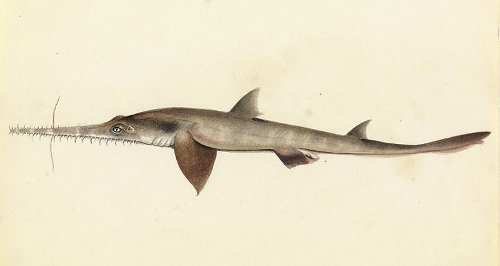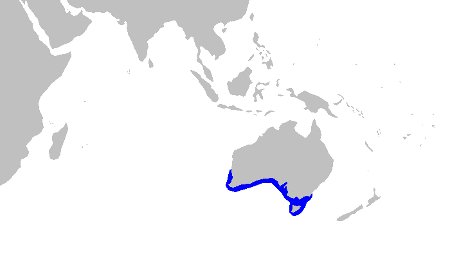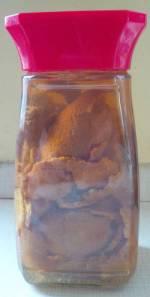Longnose Sawshark
Pristiophorus cirratus

|
The longnose sawshark, or Pristiophorus cirratus, is one of the 9 species in the Pristiophoridae family. He's the one with the most spectacular snout, hence the name. But just so he doesn't get ideas above his station, he's also known as the Common Sawshark. Unfortunately we don't have a photograph of one for this page, so he can't be that common;) Oh
well, I've never been to Australia and it is on my list of places to
visit. |
|
We'll just have to get ourselves over there and see if we can find one to shoot. With a camera, of course!
Size
Pups are between 31 and 34cm at birth. Mature adults average about 90cm but can get as long as about 140cm.
Colouring
Yellowish to greyish or sandy brown with varied darker patches, bands and blotches on top and pale to white underneath. The underside of the snout is a pale pinkish colour.
Fins
They have two dorsal fins with the rear one being slightly smaller than the front one. They're set well back on the body. They have paired pelvic and pectoral fins but no anal fin. The caudal fin has along upper lobe, but no lower lobe.
Teeth
The teeth on the rostrum are very sharp and alternate between one larger and one smaller tooth all the way up. There are about 20 teeth along each side. They also have 40 - 50 teeth in their upper jaw.
The toothy snout is not only a formidable weapon, but also a well adapted sensory organ. With a pair of barbels situated about halfway along, and ampulae of lorenzini, it is capable of locating prey by sensing vibration, bioelectricity and chemical concentrations in the surrounding water.
Once it has detected a meal it goes into slasher mode and kills or disables the prey with a side to side swiping movement of the snout. It can also use the snout to grub prey up out of the sand or mud of the seabed.
Diet
The longnose sawshark likes small fish and crustaceans and is partial to a bit of squid too.
Reproduction
These sharks are ovoviviparous. The pups are born with the rostral teeth lying flat against the rostrum to prevent injury to the mother. Litters of around 5 - 20 pups are born every two years. The gestation period is thought to be around a year.
Distribution
This shark is found off the coast of southern Australia at depths of between about 40 and 300m. They prefer sandy or gravel sand bottoms and occasionally come close inshore into estuaries and bays.
Longnose Sawshark Distribution Map

Return to Saw Sharks from Longnose Sawshark
Classification
Phylum: Chordata
Class: Chondrichthyes
Subclass: Elsamobranchii
Order: Pristophoriformes
Family: Pristiophoridae
Genus: Pristiophorus
Species: cirratus
Recent Articles
-
Thresher Sharks
Aug 27, 14 10:51 AM
Thresher sharks are unmistakable with that huge upper lobe on the caudal fin. Let's find out more about them. -
Sharkwater
Aug 14, 14 12:42 PM
Sharkwater is a documentary by Rob Stewart highlighting the plight of the sharks in our oceans. -
Natural Cleaners
Aug 13, 14 08:57 AM
Natural cleaners and homemade skincare products are not only better for the environment, they're better for you and your family.
